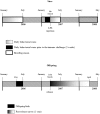Immune-mediated change in the expression of a sexual trait predicts offspring survival in the wild
- PMID: 21984912
- PMCID: PMC3184954
- DOI: 10.1371/journal.pone.0025305
Immune-mediated change in the expression of a sexual trait predicts offspring survival in the wild
Abstract
Background: The "good genes" theory of sexual selection postulates that females choose mates that will improve their offspring's fitness through the inheritance of paternal genes. In spite of the attention that this hypothesis has given rise to, the empirical evidence remains sparse, mostly because of the difficulties of controlling for the many environmental factors that may covary with both the paternal phenotype and offspring fitness. Here, we tested the hypothesis that offspring sired by males of a preferred phenotype should have better survival in an endangered bird, the houbara bustard (Chlamydotis undulata undulata).
Methodology/principal findings: We tested if natural and experimentally-induced variation in courtship display (following an inflammatory challenge) predicts the survival of offspring. Chicks were produced by artificial insemination of females, ensuring that any effect on survival could only arise from the transfer of paternal genes. One hundred and twenty offspring were equipped with radio transmitters, and their survival monitored in the wild for a year. This allowed assessment of the potential benefits of paternal genes in a natural setting, where birds experience the whole range of environmental hazards. Although natural variation in sire courtship display did not predict offspring survival, sires that withstood the inflammatory insult and maintained their courtship activity sired offspring with the best survival upon release.
Conclusions: This finding is relevant both to enlighten the debate on "good genes" sexual selection and the management of supportive breeding programs.
Conflict of interest statement
Figures



Similar articles
-
Seasonal variation of LH, sex steroids, body mass, molt, display, and laying in two subspecies of Houbara bustard, Chlamydotis undulata macqueenii and Chlamydotis undulata undulata, housed in outdoor cages under natural conditions.Gen Comp Endocrinol. 1996 Apr;102(1):102-12. doi: 10.1006/gcen.1996.0051. Gen Comp Endocrinol. 1996. PMID: 8860314
-
Male health status, signalled by courtship display, reveals ejaculate quality and hatching success in a lekking species.J Anim Ecol. 2010 Jul;79(4):843-50. doi: 10.1111/j.1365-2656.2010.01696.x. Epub 2010 Apr 20. J Anim Ecol. 2010. PMID: 20412349
-
Oxidative stress during courtship affects male and female reproductive effort differentially in a wild bird with biparental care.J Exp Biol. 2016 Dec 15;219(Pt 24):3915-3926. doi: 10.1242/jeb.141325. Epub 2016 Oct 6. J Exp Biol. 2016. PMID: 27802141
-
Ethological concepts revisited: immediate early gene induction in response to sexual stimuli in birds.Brain Behav Evol. 2001 May;57(5):252-70. doi: 10.1159/000047244. Brain Behav Evol. 2001. PMID: 11641562 Review.
-
Behavior, natural history and neuroendocrinology of a tropical bird.Gen Comp Endocrinol. 2008 Jul;157(3):254-8. doi: 10.1016/j.ygcen.2008.05.015. Epub 2008 May 29. Gen Comp Endocrinol. 2008. PMID: 18579141 Review.
Cited by
-
Does recognized genetic management in supportive breeding prevent genetic changes in life-history traits?Evol Appl. 2014 May;7(5):521-32. doi: 10.1111/eva.12150. Epub 2014 Mar 27. Evol Appl. 2014. PMID: 24944566 Free PMC article.
-
Can sexual selection theory inform genetic management of captive populations? A review.Evol Appl. 2014 Nov;7(9):1120-33. doi: 10.1111/eva.12229. Epub 2014 Oct 29. Evol Appl. 2014. PMID: 25553072 Free PMC article.
-
Diversity of avipoxviruses in captive-bred Houbara bustard.Vet Res. 2014 Oct 1;45(1):98. doi: 10.1186/s13567-014-0098-3. Vet Res. 2014. PMID: 25270742 Free PMC article.
-
Can Neglected Tropical Diseases Compromise Human Wellbeing in Sex-, Age-, and Trait-Specific Ways?PLoS Negl Trop Dis. 2016 Apr 14;10(4):e0004489. doi: 10.1371/journal.pntd.0004489. eCollection 2016 Apr. PLoS Negl Trop Dis. 2016. PMID: 27077746 Free PMC article. Review.
References
-
- Andersson M, Simmons LW. Sexual selection and mate choice. Trends Ecol Evol. 2006;21:296–302. - PubMed
-
- Zahavi A. Mate selection – selection for a handicap. J Theor Biol. 1975;53:205–214. - PubMed
-
- Grafen A. Biological signals as handicaps. J Theor Biol. 1990;144:517–546. - PubMed
-
- Møller AP, Jennions MD. How important are direct fitness benefits of sexual selection? Naturwissenschaften. 2001;88:401–415. - PubMed
-
- Petrie M. Improved growth and survival of offspring of peacocks with more elaborate trains. Nature. 1994;371:598–599.
Publication types
MeSH terms
Substances
LinkOut - more resources
Full Text Sources

